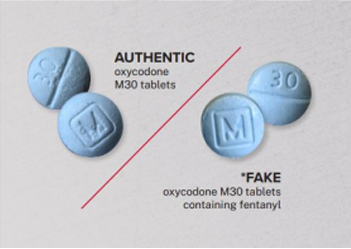Fentanyl Warning


Fentanyl is very common in our community, and has recently caused the deaths of several students in neighboring districts due to accidental overdoses. Please read below for more information and ways to help keep your family safe and healthy.
Fentanyl is a synthetic opioid that is 50 to 100 times more potent than morphine, and is odorless, tasteless and colorless. Teens are purchasing what they think are OxyContin, Percoset or Xanax pills via social media, but drug dealers are making these fake pills with the cheaper, stronger, and more deadly synthetic drug called fentanyl to increase their profits. One pill is enough to cause a deadly overdose.
The pills are nicknamed “Blues” for their common color (though they can come in other colors) or “M30s” for the stamp on the pills. There is no way to tell the difference between a counterfeit pill and a pill manufactured by a pharmaceutical company.
These pills are mostly made outside the country, and there is no quality control. Pills in the same batch can have wildly varying levels of fentanyl. The amount of fentanyl is takes to overdose and die is equivalent to two grains of sand.
The best prevention is talking to your student about never taking any medication that doesn’t come from their doctor. This includes never taking pills, even from friends. This is a conversation that can literally save your child’s life.
Other prevention strategies include:
- Open Communication: One of the best ways to protect youth from substances is by having open communication and educating them on the risks of substance use. Listening to them without judging is a critical tool you can provide as their trusted adult.
- Look for Changes in Behavior: Look out for changes in behavior, such as irregular eating or sleeping patterns, low energy, general signs of depression or anxiety, unusual irritability, slipping grades, lack of interest in activities they love, and even drastic clothing style changes. Trust your instincts. If you notice a change, ask about it.
-
Monitor Social Media: Talk to your child and monitor their social media use. The online environment provides platforms for people to sell substances. Substances can be offered by someone met online.
How to recognize a fentanyl overdose?
- Cannot be woken up or is not moving
- Breathing is slow or absent
- Discoloration of lips and nails
- Choking or coughing, gurgling sounds
- Cold or clammy skin
- Dizziness or disorientation
- Pupils extremely small
If you think someone is having an overdose, call 911 immediately and wait with the person until help arrives.
Why is fentanyl a threat to youth in Oregon?
Youth may use drugs for different reasons.
- Youth may use drugs to cope with mental health problems and stress. Many are still struggling from the effects the COVID-19 pandemic had on their lives in and outside of school.
- Youth may experiment with drugs with their friends or in social settings.
- Youth may desire oxycodone pills for the feelings of euphoria they can cause.
Fake pills are easy to get at school or via social media.
- There are accounts on social media designed to sell pills and other drugs.
- Snapchat is a popular tool for purchasing drugs because messages disappear.
When youth use illegal pills, they may not know:
- that the pills are fake. They may think the pills came from a doctor or pharmacist.
- that counterfeit pills contain fentanyl and other dangerous drugs.
- what fentanyl is, or know that one pill can be deadly.
- how to recognize and respond to an opioid overdose.
If you think your child is using fentanyl or other opioids, please contact your family physician or your school site counselor. Students and families can also report confidential concerns about substances circulating in the community by submitting an anonymous tip at safeoregon.com.
